Morrison's Employee Satisfaction: Reward Systems Impact Analysis
VerifiedAdded on 2023/06/11
|31
|7728
|108
Report
AI Summary
This report investigates the impact of reward systems on employee satisfaction at Morrison's, a major UK supermarket chain. It explores the concept of reward systems, different types of rewards used by businesses, and the benefits of these systems within the retail industry. The research examines the relationship between reward systems and employee satisfaction levels, aiming to identify effective strategies for Morrison's to enhance employee morale and retention. The methodology includes qualitative research methods, with a questionnaire distributed to 20 Morrison's employees. The findings from this research provide insights into how Morrison's can improve employee satisfaction through targeted reward initiatives. The report also includes a literature review, project methodology, results, conclusion, recommendations, and ethical considerations.
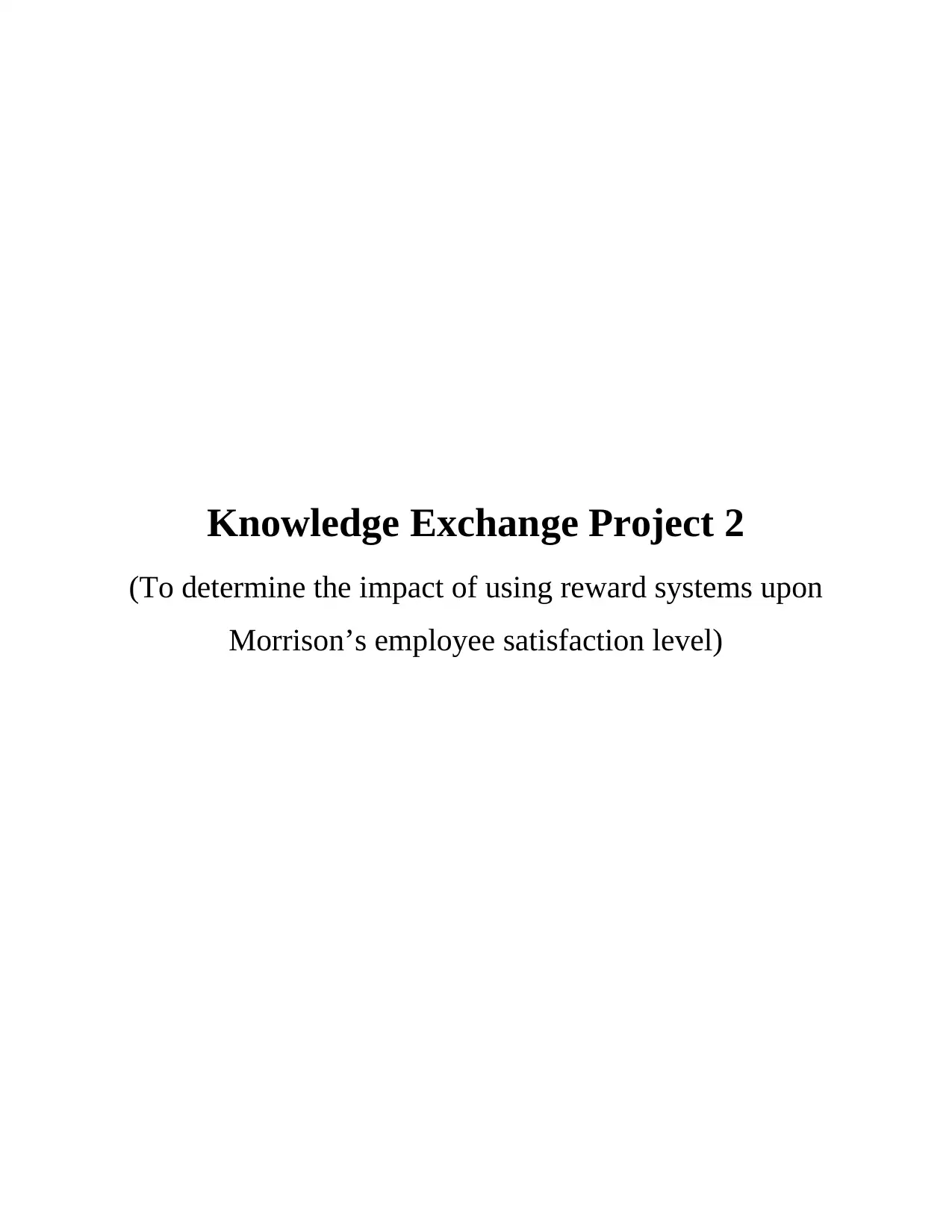
Knowledge Exchange Project 2
(To determine the impact of using reward systems upon
Morrison’s employee satisfaction level)
(To determine the impact of using reward systems upon
Morrison’s employee satisfaction level)
Paraphrase This Document
Need a fresh take? Get an instant paraphrase of this document with our AI Paraphraser
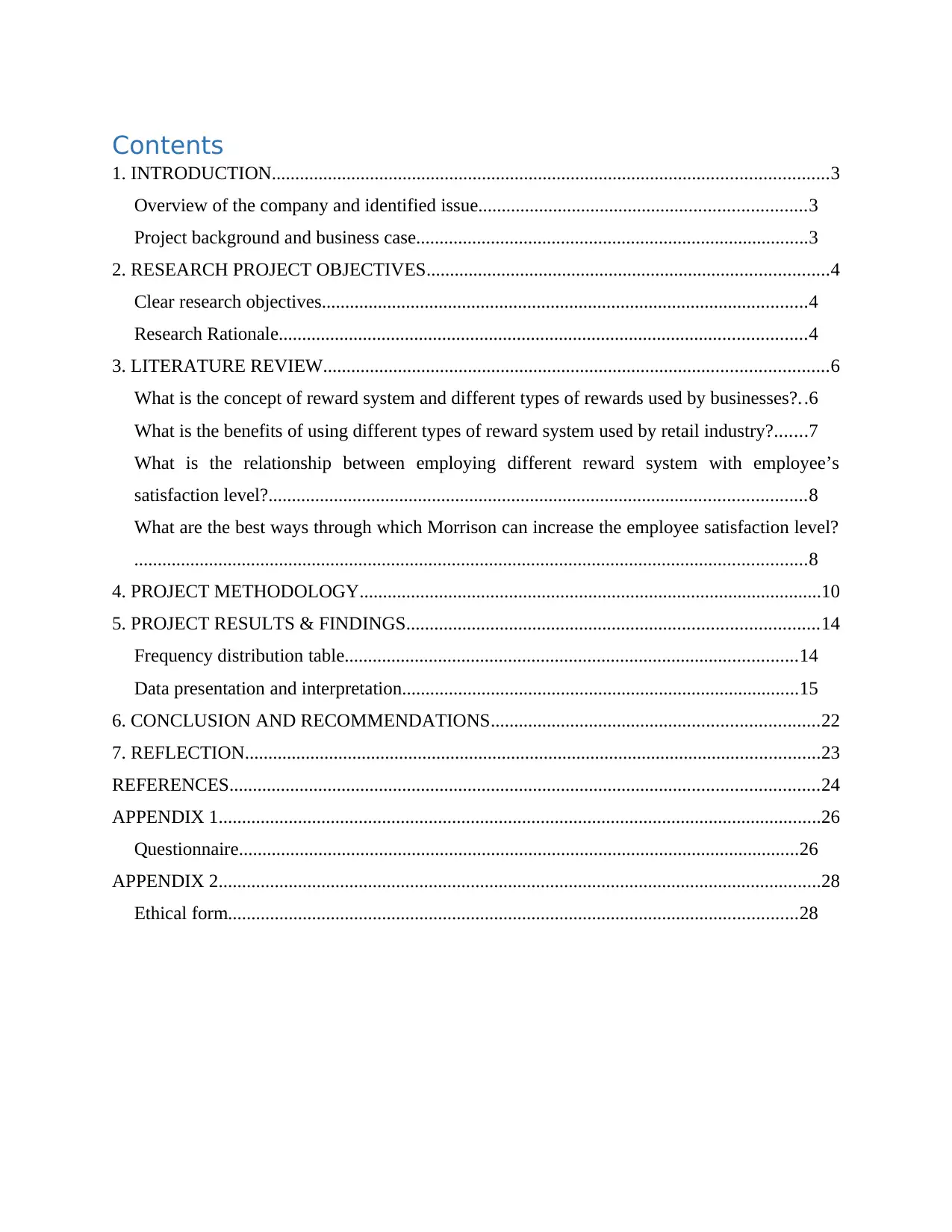
Contents
1. INTRODUCTION.......................................................................................................................3
Overview of the company and identified issue......................................................................3
Project background and business case....................................................................................3
2. RESEARCH PROJECT OBJECTIVES......................................................................................4
Clear research objectives........................................................................................................4
Research Rationale.................................................................................................................4
3. LITERATURE REVIEW............................................................................................................6
What is the concept of reward system and different types of rewards used by businesses?..6
What is the benefits of using different types of reward system used by retail industry?.......7
What is the relationship between employing different reward system with employee’s
satisfaction level?...................................................................................................................8
What are the best ways through which Morrison can increase the employee satisfaction level?
................................................................................................................................................8
4. PROJECT METHODOLOGY...................................................................................................10
5. PROJECT RESULTS & FINDINGS........................................................................................14
Frequency distribution table.................................................................................................14
Data presentation and interpretation.....................................................................................15
6. CONCLUSION AND RECOMMENDATIONS......................................................................22
7. REFLECTION...........................................................................................................................23
REFERENCES..............................................................................................................................24
APPENDIX 1.................................................................................................................................26
Questionnaire........................................................................................................................26
APPENDIX 2.................................................................................................................................28
Ethical form..........................................................................................................................28
1. INTRODUCTION.......................................................................................................................3
Overview of the company and identified issue......................................................................3
Project background and business case....................................................................................3
2. RESEARCH PROJECT OBJECTIVES......................................................................................4
Clear research objectives........................................................................................................4
Research Rationale.................................................................................................................4
3. LITERATURE REVIEW............................................................................................................6
What is the concept of reward system and different types of rewards used by businesses?..6
What is the benefits of using different types of reward system used by retail industry?.......7
What is the relationship between employing different reward system with employee’s
satisfaction level?...................................................................................................................8
What are the best ways through which Morrison can increase the employee satisfaction level?
................................................................................................................................................8
4. PROJECT METHODOLOGY...................................................................................................10
5. PROJECT RESULTS & FINDINGS........................................................................................14
Frequency distribution table.................................................................................................14
Data presentation and interpretation.....................................................................................15
6. CONCLUSION AND RECOMMENDATIONS......................................................................22
7. REFLECTION...........................................................................................................................23
REFERENCES..............................................................................................................................24
APPENDIX 1.................................................................................................................................26
Questionnaire........................................................................................................................26
APPENDIX 2.................................................................................................................................28
Ethical form..........................................................................................................................28
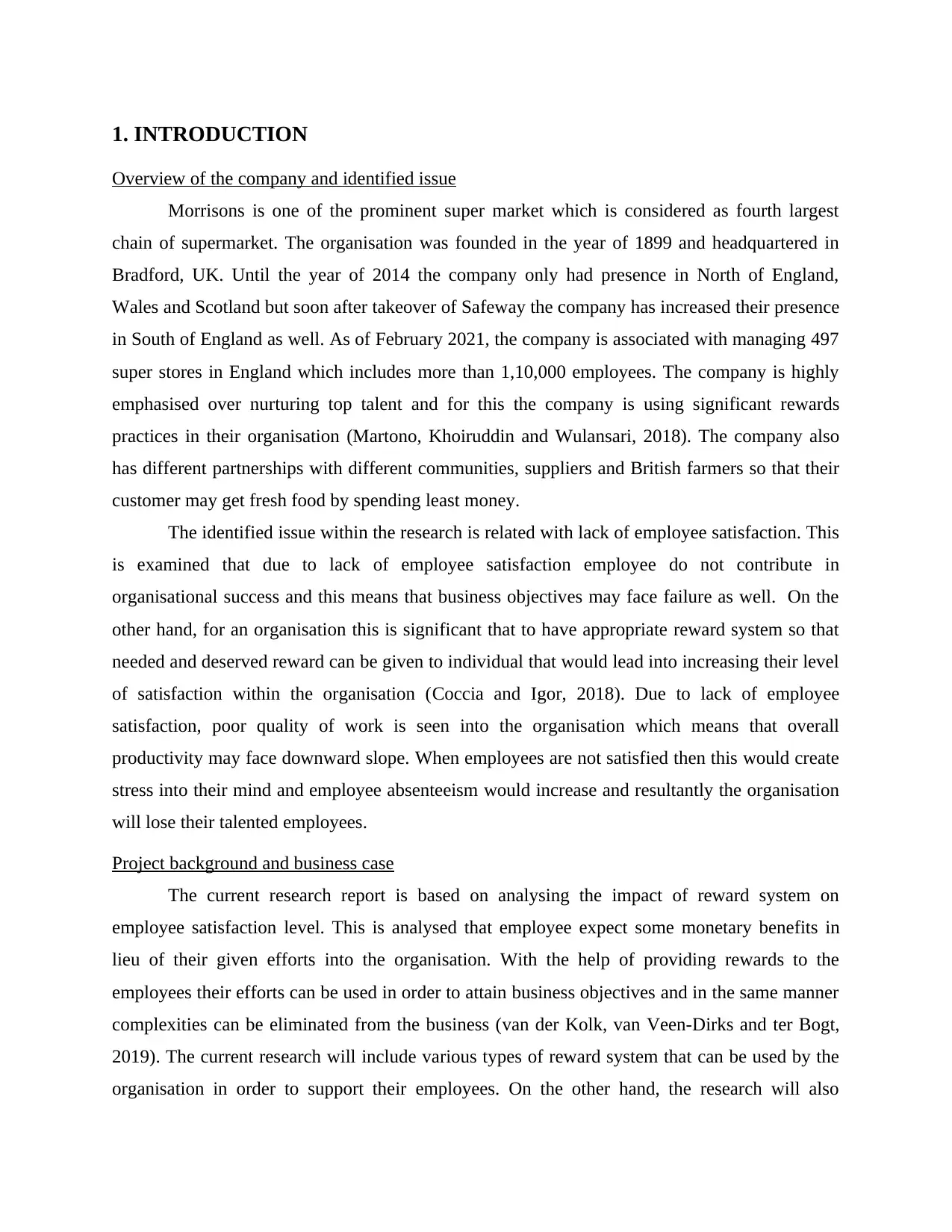
1. INTRODUCTION
Overview of the company and identified issue
Morrisons is one of the prominent super market which is considered as fourth largest
chain of supermarket. The organisation was founded in the year of 1899 and headquartered in
Bradford, UK. Until the year of 2014 the company only had presence in North of England,
Wales and Scotland but soon after takeover of Safeway the company has increased their presence
in South of England as well. As of February 2021, the company is associated with managing 497
super stores in England which includes more than 1,10,000 employees. The company is highly
emphasised over nurturing top talent and for this the company is using significant rewards
practices in their organisation (Martono, Khoiruddin and Wulansari, 2018). The company also
has different partnerships with different communities, suppliers and British farmers so that their
customer may get fresh food by spending least money.
The identified issue within the research is related with lack of employee satisfaction. This
is examined that due to lack of employee satisfaction employee do not contribute in
organisational success and this means that business objectives may face failure as well. On the
other hand, for an organisation this is significant that to have appropriate reward system so that
needed and deserved reward can be given to individual that would lead into increasing their level
of satisfaction within the organisation (Coccia and Igor, 2018). Due to lack of employee
satisfaction, poor quality of work is seen into the organisation which means that overall
productivity may face downward slope. When employees are not satisfied then this would create
stress into their mind and employee absenteeism would increase and resultantly the organisation
will lose their talented employees.
Project background and business case
The current research report is based on analysing the impact of reward system on
employee satisfaction level. This is analysed that employee expect some monetary benefits in
lieu of their given efforts into the organisation. With the help of providing rewards to the
employees their efforts can be used in order to attain business objectives and in the same manner
complexities can be eliminated from the business (van der Kolk, van Veen-Dirks and ter Bogt,
2019). The current research will include various types of reward system that can be used by the
organisation in order to support their employees. On the other hand, the research will also
Overview of the company and identified issue
Morrisons is one of the prominent super market which is considered as fourth largest
chain of supermarket. The organisation was founded in the year of 1899 and headquartered in
Bradford, UK. Until the year of 2014 the company only had presence in North of England,
Wales and Scotland but soon after takeover of Safeway the company has increased their presence
in South of England as well. As of February 2021, the company is associated with managing 497
super stores in England which includes more than 1,10,000 employees. The company is highly
emphasised over nurturing top talent and for this the company is using significant rewards
practices in their organisation (Martono, Khoiruddin and Wulansari, 2018). The company also
has different partnerships with different communities, suppliers and British farmers so that their
customer may get fresh food by spending least money.
The identified issue within the research is related with lack of employee satisfaction. This
is examined that due to lack of employee satisfaction employee do not contribute in
organisational success and this means that business objectives may face failure as well. On the
other hand, for an organisation this is significant that to have appropriate reward system so that
needed and deserved reward can be given to individual that would lead into increasing their level
of satisfaction within the organisation (Coccia and Igor, 2018). Due to lack of employee
satisfaction, poor quality of work is seen into the organisation which means that overall
productivity may face downward slope. When employees are not satisfied then this would create
stress into their mind and employee absenteeism would increase and resultantly the organisation
will lose their talented employees.
Project background and business case
The current research report is based on analysing the impact of reward system on
employee satisfaction level. This is analysed that employee expect some monetary benefits in
lieu of their given efforts into the organisation. With the help of providing rewards to the
employees their efforts can be used in order to attain business objectives and in the same manner
complexities can be eliminated from the business (van der Kolk, van Veen-Dirks and ter Bogt,
2019). The current research will include various types of reward system that can be used by the
organisation in order to support their employees. On the other hand, the research will also
⊘ This is a preview!⊘
Do you want full access?
Subscribe today to unlock all pages.

Trusted by 1+ million students worldwide
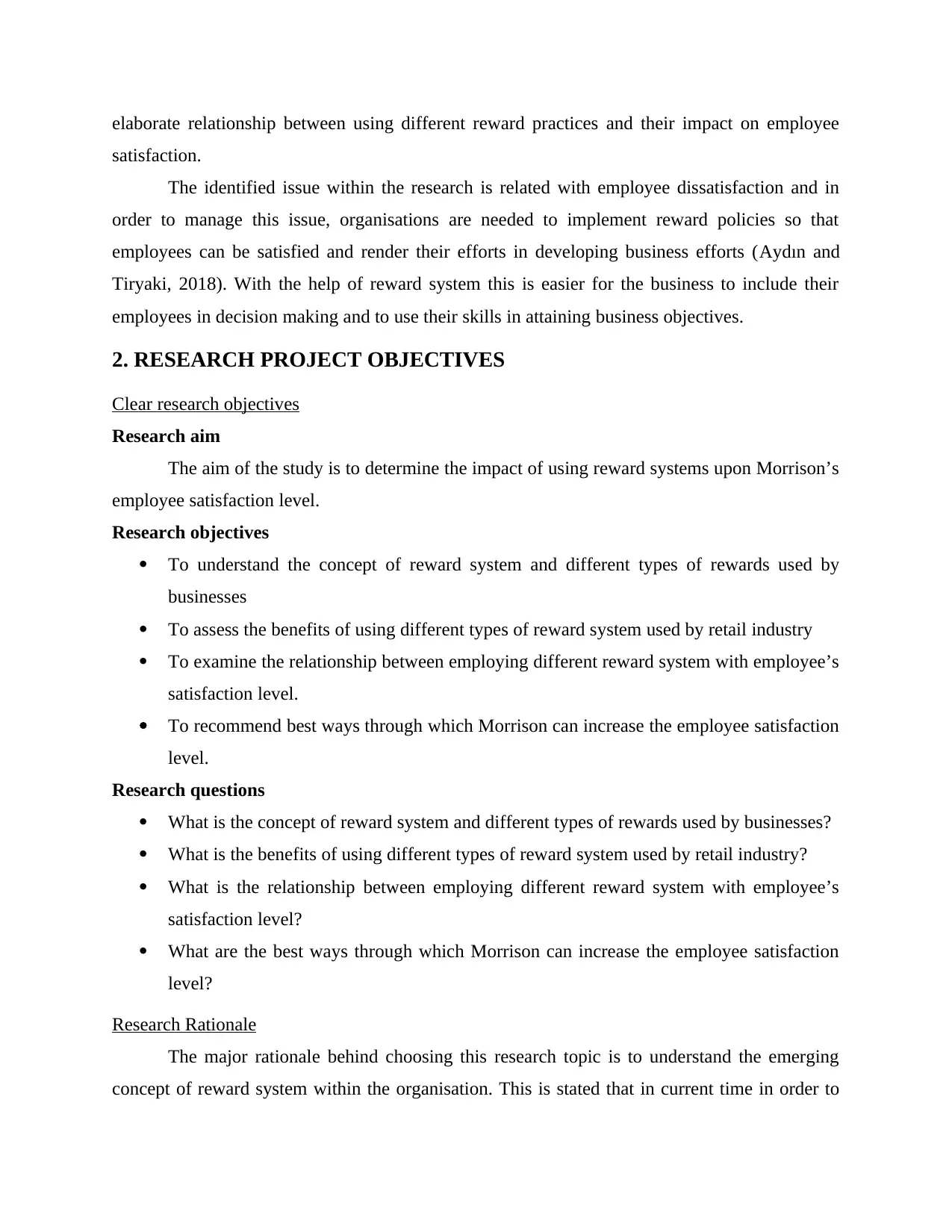
elaborate relationship between using different reward practices and their impact on employee
satisfaction.
The identified issue within the research is related with employee dissatisfaction and in
order to manage this issue, organisations are needed to implement reward policies so that
employees can be satisfied and render their efforts in developing business efforts (Aydın and
Tiryaki, 2018). With the help of reward system this is easier for the business to include their
employees in decision making and to use their skills in attaining business objectives.
2. RESEARCH PROJECT OBJECTIVES
Clear research objectives
Research aim
The aim of the study is to determine the impact of using reward systems upon Morrison’s
employee satisfaction level.
Research objectives
To understand the concept of reward system and different types of rewards used by
businesses
To assess the benefits of using different types of reward system used by retail industry
To examine the relationship between employing different reward system with employee’s
satisfaction level.
To recommend best ways through which Morrison can increase the employee satisfaction
level.
Research questions
What is the concept of reward system and different types of rewards used by businesses?
What is the benefits of using different types of reward system used by retail industry?
What is the relationship between employing different reward system with employee’s
satisfaction level?
What are the best ways through which Morrison can increase the employee satisfaction
level?
Research Rationale
The major rationale behind choosing this research topic is to understand the emerging
concept of reward system within the organisation. This is stated that in current time in order to
satisfaction.
The identified issue within the research is related with employee dissatisfaction and in
order to manage this issue, organisations are needed to implement reward policies so that
employees can be satisfied and render their efforts in developing business efforts (Aydın and
Tiryaki, 2018). With the help of reward system this is easier for the business to include their
employees in decision making and to use their skills in attaining business objectives.
2. RESEARCH PROJECT OBJECTIVES
Clear research objectives
Research aim
The aim of the study is to determine the impact of using reward systems upon Morrison’s
employee satisfaction level.
Research objectives
To understand the concept of reward system and different types of rewards used by
businesses
To assess the benefits of using different types of reward system used by retail industry
To examine the relationship between employing different reward system with employee’s
satisfaction level.
To recommend best ways through which Morrison can increase the employee satisfaction
level.
Research questions
What is the concept of reward system and different types of rewards used by businesses?
What is the benefits of using different types of reward system used by retail industry?
What is the relationship between employing different reward system with employee’s
satisfaction level?
What are the best ways through which Morrison can increase the employee satisfaction
level?
Research Rationale
The major rationale behind choosing this research topic is to understand the emerging
concept of reward system within the organisation. This is stated that in current time in order to
Paraphrase This Document
Need a fresh take? Get an instant paraphrase of this document with our AI Paraphraser
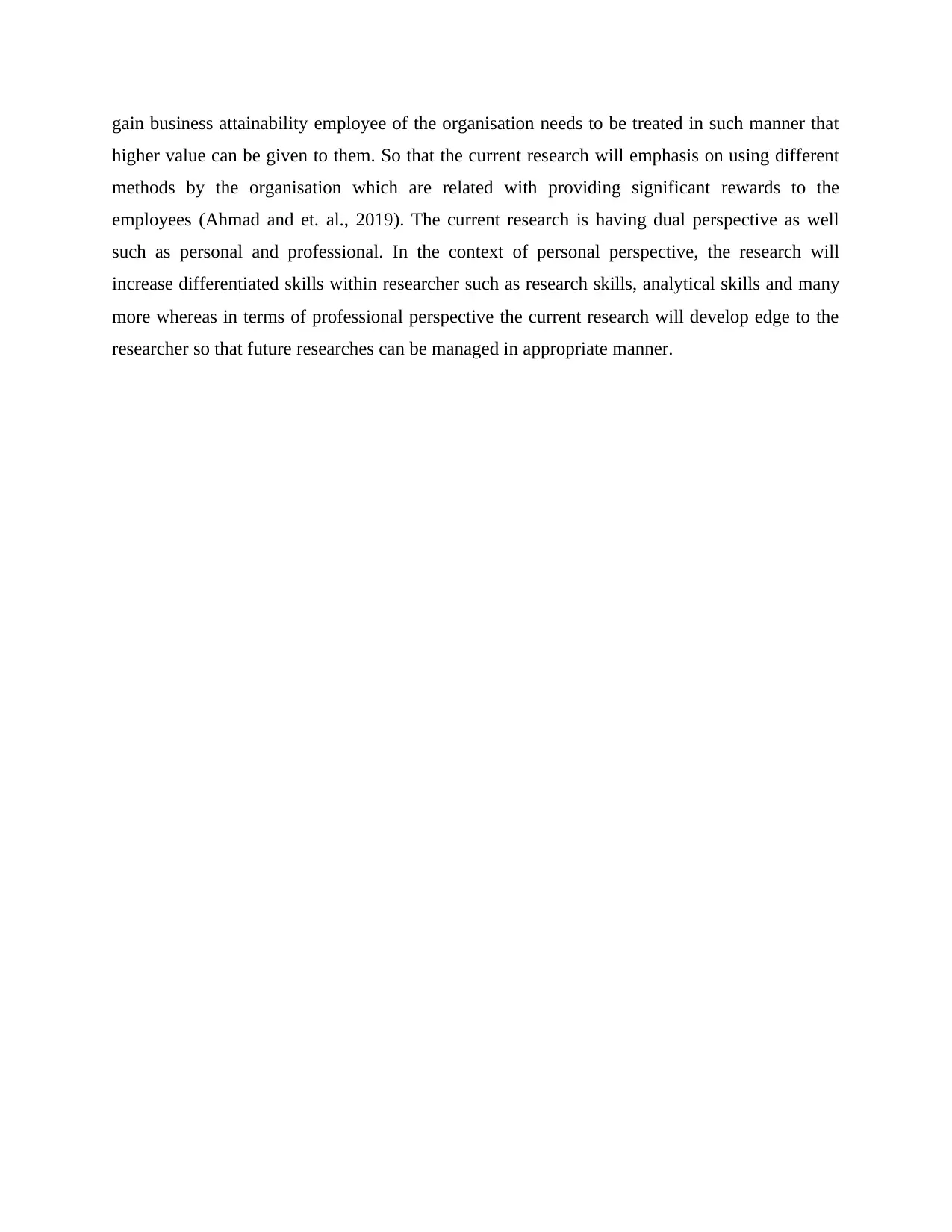
gain business attainability employee of the organisation needs to be treated in such manner that
higher value can be given to them. So that the current research will emphasis on using different
methods by the organisation which are related with providing significant rewards to the
employees (Ahmad and et. al., 2019). The current research is having dual perspective as well
such as personal and professional. In the context of personal perspective, the research will
increase differentiated skills within researcher such as research skills, analytical skills and many
more whereas in terms of professional perspective the current research will develop edge to the
researcher so that future researches can be managed in appropriate manner.
higher value can be given to them. So that the current research will emphasis on using different
methods by the organisation which are related with providing significant rewards to the
employees (Ahmad and et. al., 2019). The current research is having dual perspective as well
such as personal and professional. In the context of personal perspective, the research will
increase differentiated skills within researcher such as research skills, analytical skills and many
more whereas in terms of professional perspective the current research will develop edge to the
researcher so that future researches can be managed in appropriate manner.
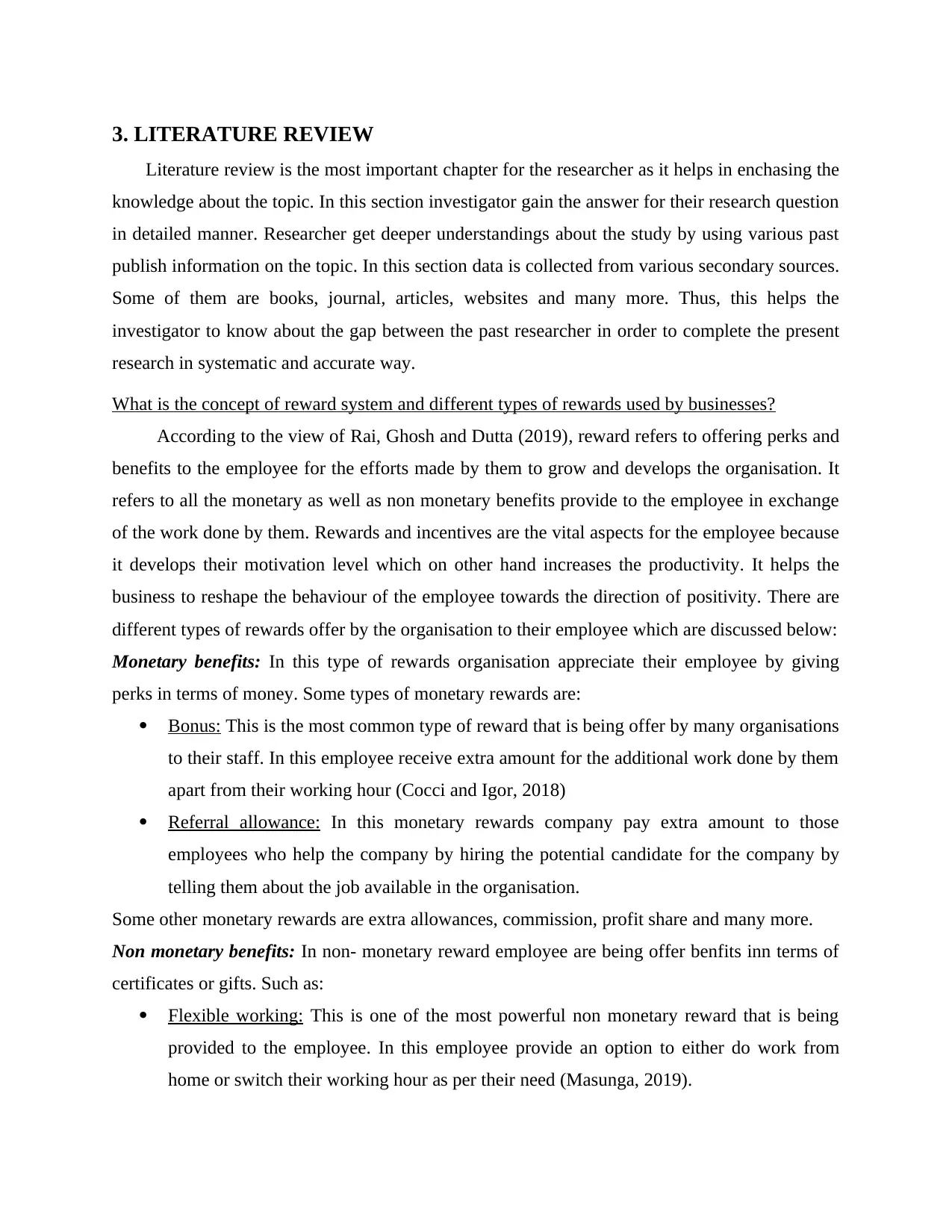
3. LITERATURE REVIEW
Literature review is the most important chapter for the researcher as it helps in enchasing the
knowledge about the topic. In this section investigator gain the answer for their research question
in detailed manner. Researcher get deeper understandings about the study by using various past
publish information on the topic. In this section data is collected from various secondary sources.
Some of them are books, journal, articles, websites and many more. Thus, this helps the
investigator to know about the gap between the past researcher in order to complete the present
research in systematic and accurate way.
What is the concept of reward system and different types of rewards used by businesses?
According to the view of Rai, Ghosh and Dutta (2019), reward refers to offering perks and
benefits to the employee for the efforts made by them to grow and develops the organisation. It
refers to all the monetary as well as non monetary benefits provide to the employee in exchange
of the work done by them. Rewards and incentives are the vital aspects for the employee because
it develops their motivation level which on other hand increases the productivity. It helps the
business to reshape the behaviour of the employee towards the direction of positivity. There are
different types of rewards offer by the organisation to their employee which are discussed below:
Monetary benefits: In this type of rewards organisation appreciate their employee by giving
perks in terms of money. Some types of monetary rewards are:
Bonus: This is the most common type of reward that is being offer by many organisations
to their staff. In this employee receive extra amount for the additional work done by them
apart from their working hour (Cocci and Igor, 2018)
Referral allowance: In this monetary rewards company pay extra amount to those
employees who help the company by hiring the potential candidate for the company by
telling them about the job available in the organisation.
Some other monetary rewards are extra allowances, commission, profit share and many more.
Non monetary benefits: In non- monetary reward employee are being offer benfits inn terms of
certificates or gifts. Such as:
Flexible working: This is one of the most powerful non monetary reward that is being
provided to the employee. In this employee provide an option to either do work from
home or switch their working hour as per their need (Masunga, 2019).
Literature review is the most important chapter for the researcher as it helps in enchasing the
knowledge about the topic. In this section investigator gain the answer for their research question
in detailed manner. Researcher get deeper understandings about the study by using various past
publish information on the topic. In this section data is collected from various secondary sources.
Some of them are books, journal, articles, websites and many more. Thus, this helps the
investigator to know about the gap between the past researcher in order to complete the present
research in systematic and accurate way.
What is the concept of reward system and different types of rewards used by businesses?
According to the view of Rai, Ghosh and Dutta (2019), reward refers to offering perks and
benefits to the employee for the efforts made by them to grow and develops the organisation. It
refers to all the monetary as well as non monetary benefits provide to the employee in exchange
of the work done by them. Rewards and incentives are the vital aspects for the employee because
it develops their motivation level which on other hand increases the productivity. It helps the
business to reshape the behaviour of the employee towards the direction of positivity. There are
different types of rewards offer by the organisation to their employee which are discussed below:
Monetary benefits: In this type of rewards organisation appreciate their employee by giving
perks in terms of money. Some types of monetary rewards are:
Bonus: This is the most common type of reward that is being offer by many organisations
to their staff. In this employee receive extra amount for the additional work done by them
apart from their working hour (Cocci and Igor, 2018)
Referral allowance: In this monetary rewards company pay extra amount to those
employees who help the company by hiring the potential candidate for the company by
telling them about the job available in the organisation.
Some other monetary rewards are extra allowances, commission, profit share and many more.
Non monetary benefits: In non- monetary reward employee are being offer benfits inn terms of
certificates or gifts. Such as:
Flexible working: This is one of the most powerful non monetary reward that is being
provided to the employee. In this employee provide an option to either do work from
home or switch their working hour as per their need (Masunga, 2019).
⊘ This is a preview!⊘
Do you want full access?
Subscribe today to unlock all pages.

Trusted by 1+ million students worldwide
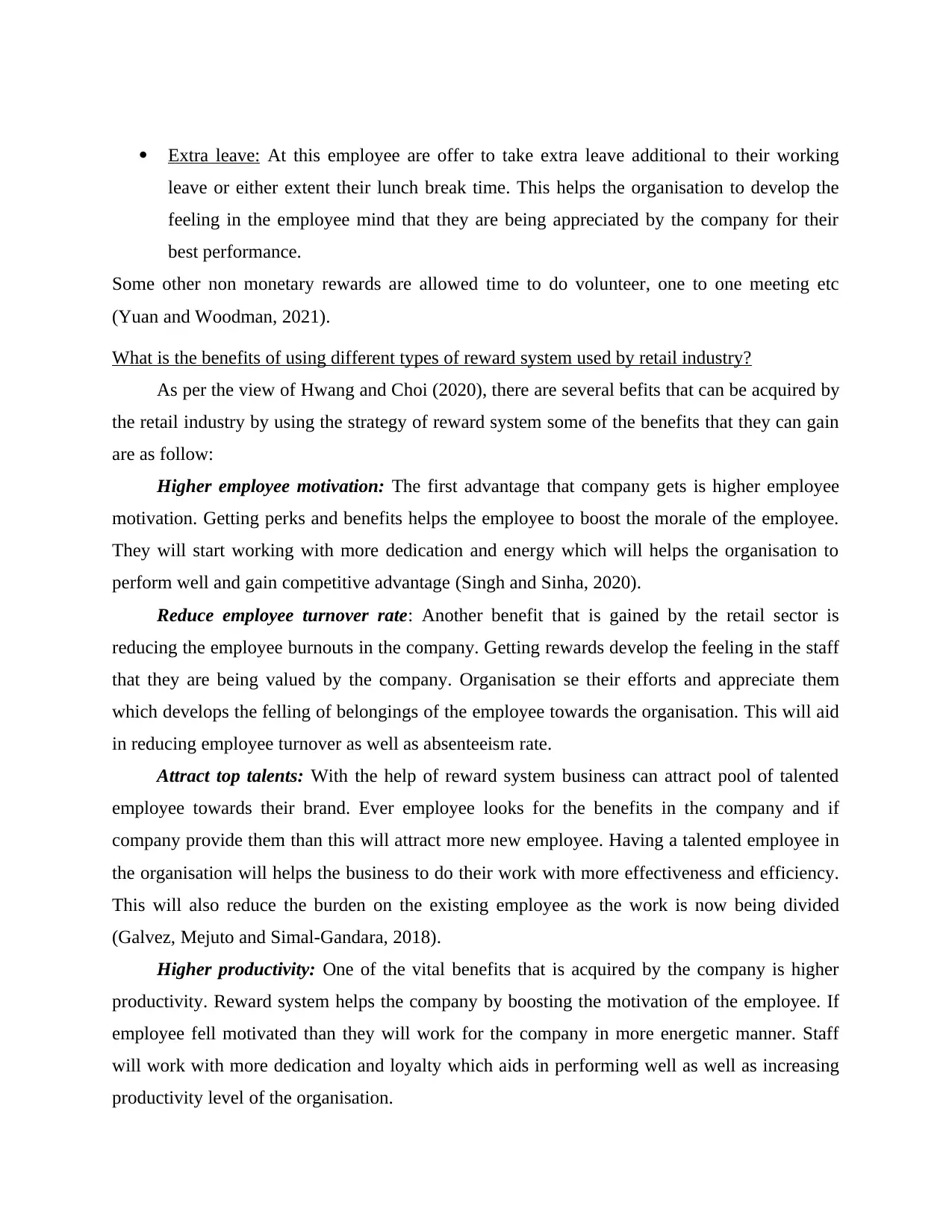
Extra leave: At this employee are offer to take extra leave additional to their working
leave or either extent their lunch break time. This helps the organisation to develop the
feeling in the employee mind that they are being appreciated by the company for their
best performance.
Some other non monetary rewards are allowed time to do volunteer, one to one meeting etc
(Yuan and Woodman, 2021).
What is the benefits of using different types of reward system used by retail industry?
As per the view of Hwang and Choi (2020), there are several befits that can be acquired by
the retail industry by using the strategy of reward system some of the benefits that they can gain
are as follow:
Higher employee motivation: The first advantage that company gets is higher employee
motivation. Getting perks and benefits helps the employee to boost the morale of the employee.
They will start working with more dedication and energy which will helps the organisation to
perform well and gain competitive advantage (Singh and Sinha, 2020).
Reduce employee turnover rate: Another benefit that is gained by the retail sector is
reducing the employee burnouts in the company. Getting rewards develop the feeling in the staff
that they are being valued by the company. Organisation se their efforts and appreciate them
which develops the felling of belongings of the employee towards the organisation. This will aid
in reducing employee turnover as well as absenteeism rate.
Attract top talents: With the help of reward system business can attract pool of talented
employee towards their brand. Ever employee looks for the benefits in the company and if
company provide them than this will attract more new employee. Having a talented employee in
the organisation will helps the business to do their work with more effectiveness and efficiency.
This will also reduce the burden on the existing employee as the work is now being divided
(Galvez, Mejuto and Simal-Gandara, 2018).
Higher productivity: One of the vital benefits that is acquired by the company is higher
productivity. Reward system helps the company by boosting the motivation of the employee. If
employee fell motivated than they will work for the company in more energetic manner. Staff
will work with more dedication and loyalty which aids in performing well as well as increasing
productivity level of the organisation.
leave or either extent their lunch break time. This helps the organisation to develop the
feeling in the employee mind that they are being appreciated by the company for their
best performance.
Some other non monetary rewards are allowed time to do volunteer, one to one meeting etc
(Yuan and Woodman, 2021).
What is the benefits of using different types of reward system used by retail industry?
As per the view of Hwang and Choi (2020), there are several befits that can be acquired by
the retail industry by using the strategy of reward system some of the benefits that they can gain
are as follow:
Higher employee motivation: The first advantage that company gets is higher employee
motivation. Getting perks and benefits helps the employee to boost the morale of the employee.
They will start working with more dedication and energy which will helps the organisation to
perform well and gain competitive advantage (Singh and Sinha, 2020).
Reduce employee turnover rate: Another benefit that is gained by the retail sector is
reducing the employee burnouts in the company. Getting rewards develop the feeling in the staff
that they are being valued by the company. Organisation se their efforts and appreciate them
which develops the felling of belongings of the employee towards the organisation. This will aid
in reducing employee turnover as well as absenteeism rate.
Attract top talents: With the help of reward system business can attract pool of talented
employee towards their brand. Ever employee looks for the benefits in the company and if
company provide them than this will attract more new employee. Having a talented employee in
the organisation will helps the business to do their work with more effectiveness and efficiency.
This will also reduce the burden on the existing employee as the work is now being divided
(Galvez, Mejuto and Simal-Gandara, 2018).
Higher productivity: One of the vital benefits that is acquired by the company is higher
productivity. Reward system helps the company by boosting the motivation of the employee. If
employee fell motivated than they will work for the company in more energetic manner. Staff
will work with more dedication and loyalty which aids in performing well as well as increasing
productivity level of the organisation.
Paraphrase This Document
Need a fresh take? Get an instant paraphrase of this document with our AI Paraphraser
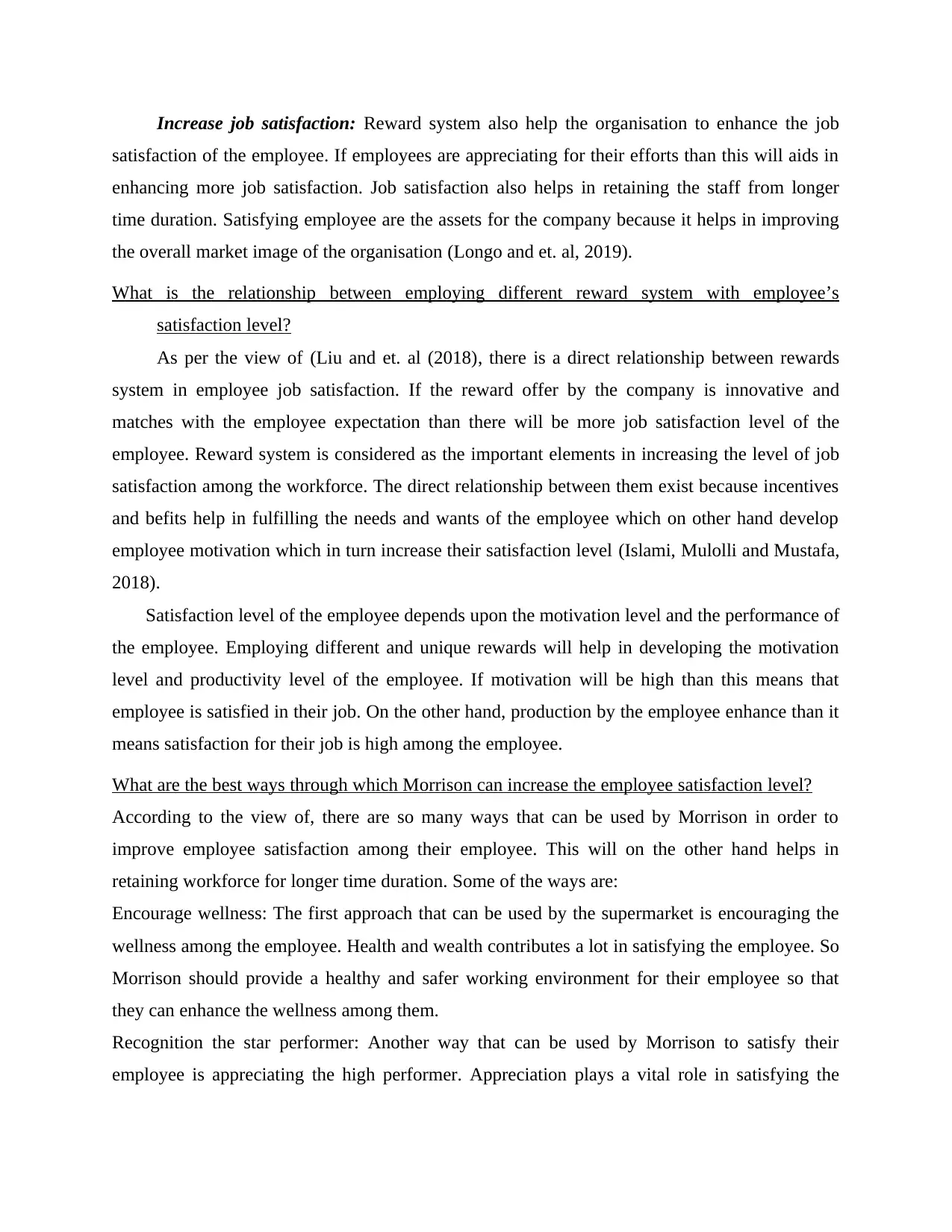
Increase job satisfaction: Reward system also help the organisation to enhance the job
satisfaction of the employee. If employees are appreciating for their efforts than this will aids in
enhancing more job satisfaction. Job satisfaction also helps in retaining the staff from longer
time duration. Satisfying employee are the assets for the company because it helps in improving
the overall market image of the organisation (Longo and et. al, 2019).
What is the relationship between employing different reward system with employee’s
satisfaction level?
As per the view of (Liu and et. al (2018), there is a direct relationship between rewards
system in employee job satisfaction. If the reward offer by the company is innovative and
matches with the employee expectation than there will be more job satisfaction level of the
employee. Reward system is considered as the important elements in increasing the level of job
satisfaction among the workforce. The direct relationship between them exist because incentives
and befits help in fulfilling the needs and wants of the employee which on other hand develop
employee motivation which in turn increase their satisfaction level (Islami, Mulolli and Mustafa,
2018).
Satisfaction level of the employee depends upon the motivation level and the performance of
the employee. Employing different and unique rewards will help in developing the motivation
level and productivity level of the employee. If motivation will be high than this means that
employee is satisfied in their job. On the other hand, production by the employee enhance than it
means satisfaction for their job is high among the employee.
What are the best ways through which Morrison can increase the employee satisfaction level?
According to the view of, there are so many ways that can be used by Morrison in order to
improve employee satisfaction among their employee. This will on the other hand helps in
retaining workforce for longer time duration. Some of the ways are:
Encourage wellness: The first approach that can be used by the supermarket is encouraging the
wellness among the employee. Health and wealth contributes a lot in satisfying the employee. So
Morrison should provide a healthy and safer working environment for their employee so that
they can enhance the wellness among them.
Recognition the star performer: Another way that can be used by Morrison to satisfy their
employee is appreciating the high performer. Appreciation plays a vital role in satisfying the
satisfaction of the employee. If employees are appreciating for their efforts than this will aids in
enhancing more job satisfaction. Job satisfaction also helps in retaining the staff from longer
time duration. Satisfying employee are the assets for the company because it helps in improving
the overall market image of the organisation (Longo and et. al, 2019).
What is the relationship between employing different reward system with employee’s
satisfaction level?
As per the view of (Liu and et. al (2018), there is a direct relationship between rewards
system in employee job satisfaction. If the reward offer by the company is innovative and
matches with the employee expectation than there will be more job satisfaction level of the
employee. Reward system is considered as the important elements in increasing the level of job
satisfaction among the workforce. The direct relationship between them exist because incentives
and befits help in fulfilling the needs and wants of the employee which on other hand develop
employee motivation which in turn increase their satisfaction level (Islami, Mulolli and Mustafa,
2018).
Satisfaction level of the employee depends upon the motivation level and the performance of
the employee. Employing different and unique rewards will help in developing the motivation
level and productivity level of the employee. If motivation will be high than this means that
employee is satisfied in their job. On the other hand, production by the employee enhance than it
means satisfaction for their job is high among the employee.
What are the best ways through which Morrison can increase the employee satisfaction level?
According to the view of, there are so many ways that can be used by Morrison in order to
improve employee satisfaction among their employee. This will on the other hand helps in
retaining workforce for longer time duration. Some of the ways are:
Encourage wellness: The first approach that can be used by the supermarket is encouraging the
wellness among the employee. Health and wealth contributes a lot in satisfying the employee. So
Morrison should provide a healthy and safer working environment for their employee so that
they can enhance the wellness among them.
Recognition the star performer: Another way that can be used by Morrison to satisfy their
employee is appreciating the high performer. Appreciation plays a vital role in satisfying the
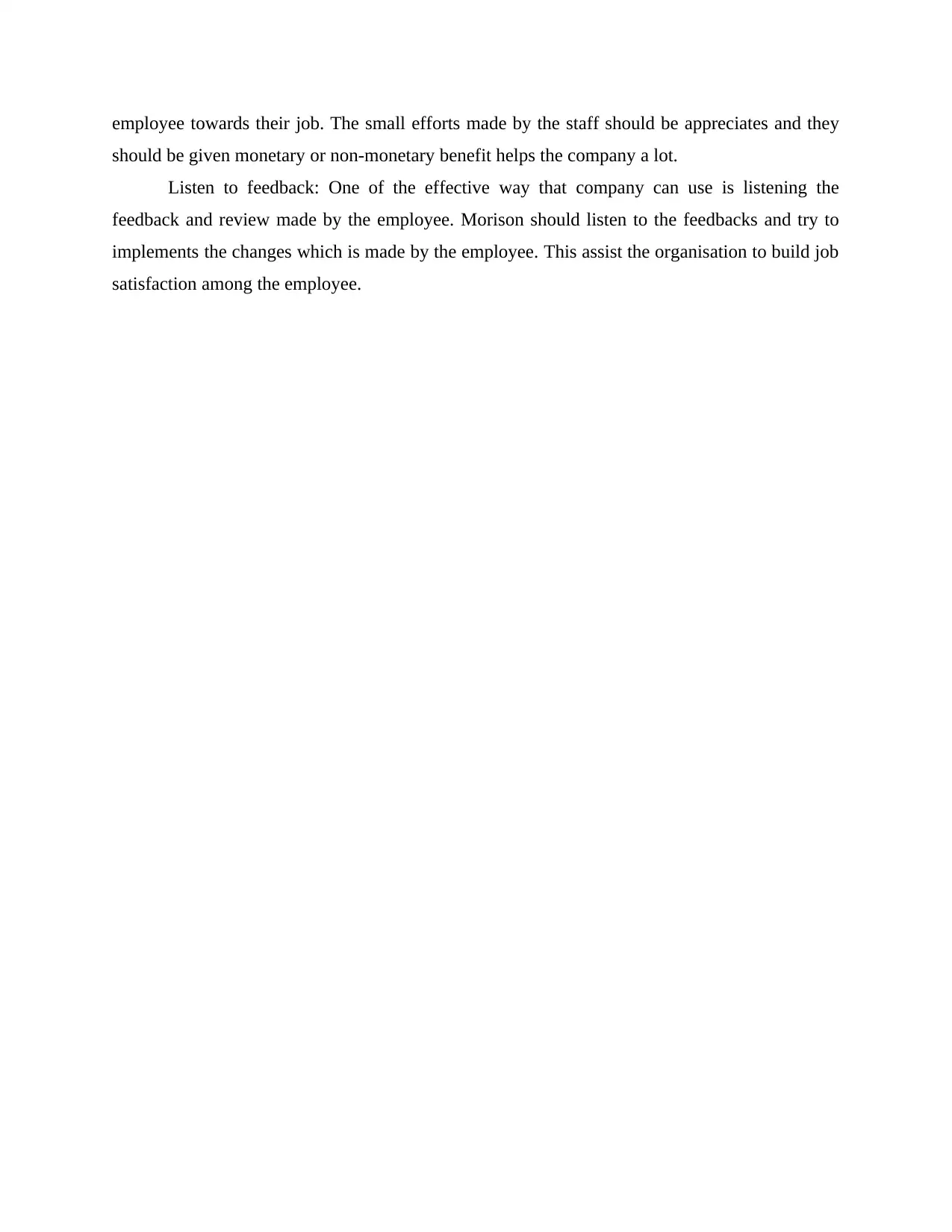
employee towards their job. The small efforts made by the staff should be appreciates and they
should be given monetary or non-monetary benefit helps the company a lot.
Listen to feedback: One of the effective way that company can use is listening the
feedback and review made by the employee. Morison should listen to the feedbacks and try to
implements the changes which is made by the employee. This assist the organisation to build job
satisfaction among the employee.
should be given monetary or non-monetary benefit helps the company a lot.
Listen to feedback: One of the effective way that company can use is listening the
feedback and review made by the employee. Morison should listen to the feedbacks and try to
implements the changes which is made by the employee. This assist the organisation to build job
satisfaction among the employee.
⊘ This is a preview!⊘
Do you want full access?
Subscribe today to unlock all pages.

Trusted by 1+ million students worldwide
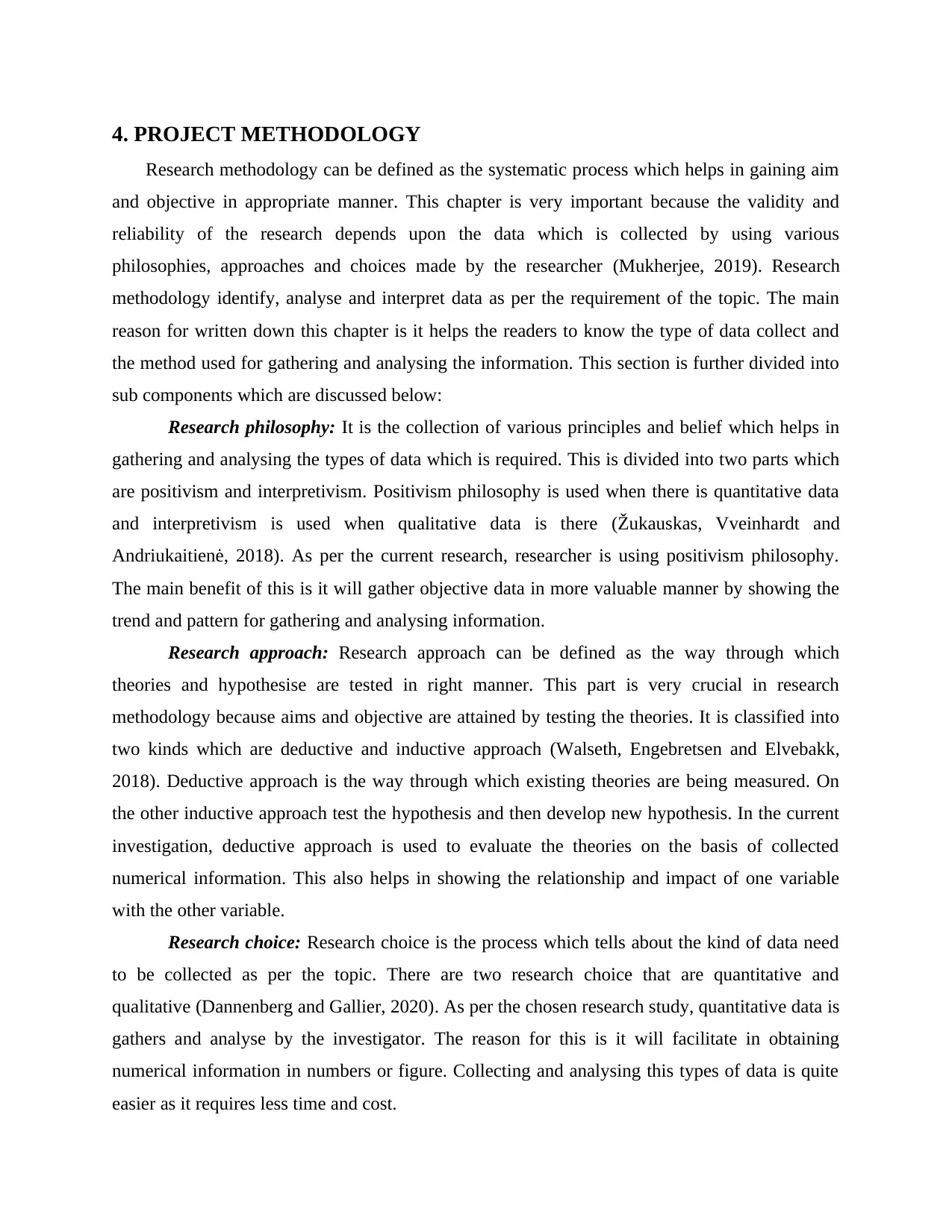
4. PROJECT METHODOLOGY
Research methodology can be defined as the systematic process which helps in gaining aim
and objective in appropriate manner. This chapter is very important because the validity and
reliability of the research depends upon the data which is collected by using various
philosophies, approaches and choices made by the researcher (Mukherjee, 2019). Research
methodology identify, analyse and interpret data as per the requirement of the topic. The main
reason for written down this chapter is it helps the readers to know the type of data collect and
the method used for gathering and analysing the information. This section is further divided into
sub components which are discussed below:
Research philosophy: It is the collection of various principles and belief which helps in
gathering and analysing the types of data which is required. This is divided into two parts which
are positivism and interpretivism. Positivism philosophy is used when there is quantitative data
and interpretivism is used when qualitative data is there (Žukauskas, Vveinhardt and
Andriukaitienė, 2018). As per the current research, researcher is using positivism philosophy.
The main benefit of this is it will gather objective data in more valuable manner by showing the
trend and pattern for gathering and analysing information.
Research approach: Research approach can be defined as the way through which
theories and hypothesise are tested in right manner. This part is very crucial in research
methodology because aims and objective are attained by testing the theories. It is classified into
two kinds which are deductive and inductive approach (Walseth, Engebretsen and Elvebakk,
2018). Deductive approach is the way through which existing theories are being measured. On
the other inductive approach test the hypothesis and then develop new hypothesis. In the current
investigation, deductive approach is used to evaluate the theories on the basis of collected
numerical information. This also helps in showing the relationship and impact of one variable
with the other variable.
Research choice: Research choice is the process which tells about the kind of data need
to be collected as per the topic. There are two research choice that are quantitative and
qualitative (Dannenberg and Gallier, 2020). As per the chosen research study, quantitative data is
gathers and analyse by the investigator. The reason for this is it will facilitate in obtaining
numerical information in numbers or figure. Collecting and analysing this types of data is quite
easier as it requires less time and cost.
Research methodology can be defined as the systematic process which helps in gaining aim
and objective in appropriate manner. This chapter is very important because the validity and
reliability of the research depends upon the data which is collected by using various
philosophies, approaches and choices made by the researcher (Mukherjee, 2019). Research
methodology identify, analyse and interpret data as per the requirement of the topic. The main
reason for written down this chapter is it helps the readers to know the type of data collect and
the method used for gathering and analysing the information. This section is further divided into
sub components which are discussed below:
Research philosophy: It is the collection of various principles and belief which helps in
gathering and analysing the types of data which is required. This is divided into two parts which
are positivism and interpretivism. Positivism philosophy is used when there is quantitative data
and interpretivism is used when qualitative data is there (Žukauskas, Vveinhardt and
Andriukaitienė, 2018). As per the current research, researcher is using positivism philosophy.
The main benefit of this is it will gather objective data in more valuable manner by showing the
trend and pattern for gathering and analysing information.
Research approach: Research approach can be defined as the way through which
theories and hypothesise are tested in right manner. This part is very crucial in research
methodology because aims and objective are attained by testing the theories. It is classified into
two kinds which are deductive and inductive approach (Walseth, Engebretsen and Elvebakk,
2018). Deductive approach is the way through which existing theories are being measured. On
the other inductive approach test the hypothesis and then develop new hypothesis. In the current
investigation, deductive approach is used to evaluate the theories on the basis of collected
numerical information. This also helps in showing the relationship and impact of one variable
with the other variable.
Research choice: Research choice is the process which tells about the kind of data need
to be collected as per the topic. There are two research choice that are quantitative and
qualitative (Dannenberg and Gallier, 2020). As per the chosen research study, quantitative data is
gathers and analyse by the investigator. The reason for this is it will facilitate in obtaining
numerical information in numbers or figure. Collecting and analysing this types of data is quite
easier as it requires less time and cost.
Paraphrase This Document
Need a fresh take? Get an instant paraphrase of this document with our AI Paraphraser
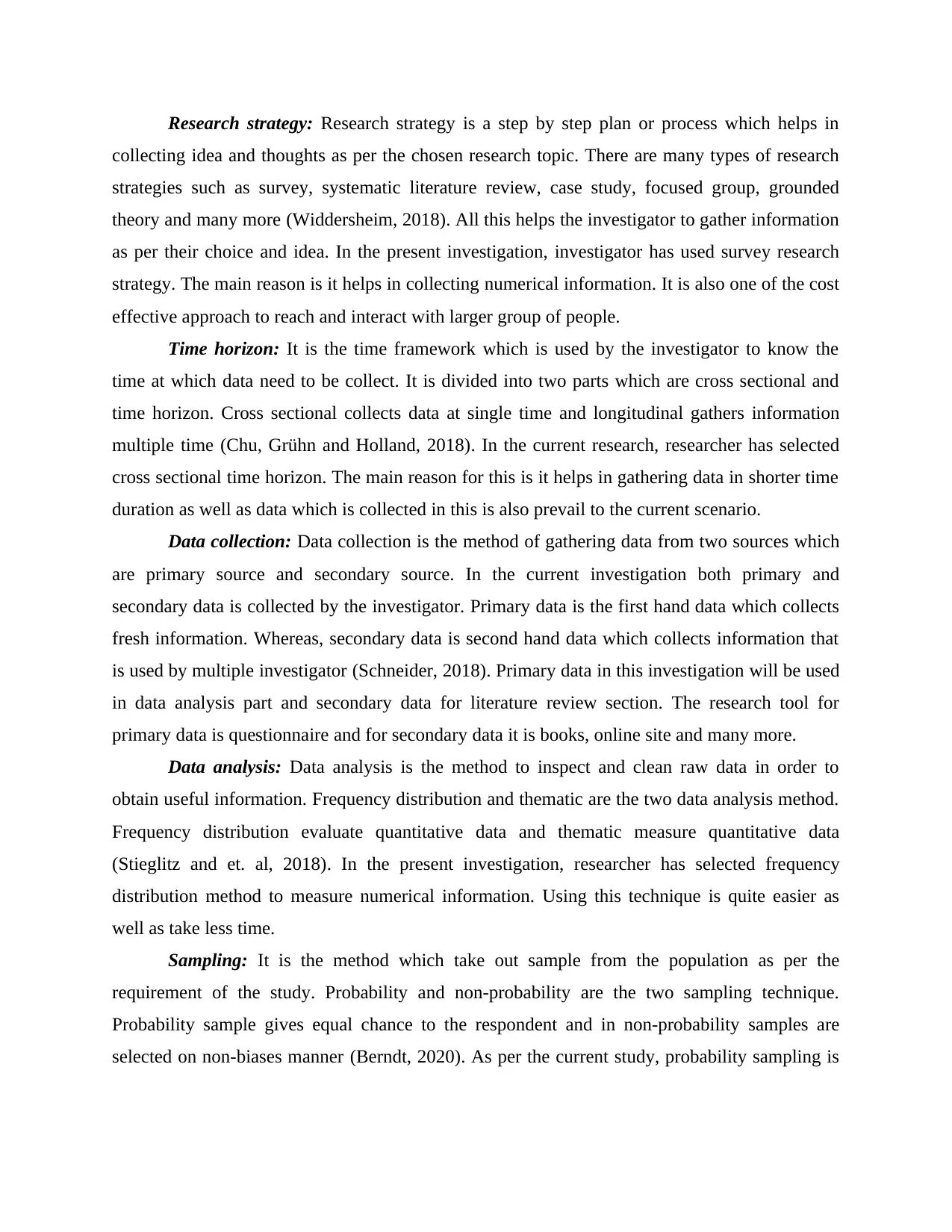
Research strategy: Research strategy is a step by step plan or process which helps in
collecting idea and thoughts as per the chosen research topic. There are many types of research
strategies such as survey, systematic literature review, case study, focused group, grounded
theory and many more (Widdersheim, 2018). All this helps the investigator to gather information
as per their choice and idea. In the present investigation, investigator has used survey research
strategy. The main reason is it helps in collecting numerical information. It is also one of the cost
effective approach to reach and interact with larger group of people.
Time horizon: It is the time framework which is used by the investigator to know the
time at which data need to be collect. It is divided into two parts which are cross sectional and
time horizon. Cross sectional collects data at single time and longitudinal gathers information
multiple time (Chu, Grühn and Holland, 2018). In the current research, researcher has selected
cross sectional time horizon. The main reason for this is it helps in gathering data in shorter time
duration as well as data which is collected in this is also prevail to the current scenario.
Data collection: Data collection is the method of gathering data from two sources which
are primary source and secondary source. In the current investigation both primary and
secondary data is collected by the investigator. Primary data is the first hand data which collects
fresh information. Whereas, secondary data is second hand data which collects information that
is used by multiple investigator (Schneider, 2018). Primary data in this investigation will be used
in data analysis part and secondary data for literature review section. The research tool for
primary data is questionnaire and for secondary data it is books, online site and many more.
Data analysis: Data analysis is the method to inspect and clean raw data in order to
obtain useful information. Frequency distribution and thematic are the two data analysis method.
Frequency distribution evaluate quantitative data and thematic measure quantitative data
(Stieglitz and et. al, 2018). In the present investigation, researcher has selected frequency
distribution method to measure numerical information. Using this technique is quite easier as
well as take less time.
Sampling: It is the method which take out sample from the population as per the
requirement of the study. Probability and non-probability are the two sampling technique.
Probability sample gives equal chance to the respondent and in non-probability samples are
selected on non-biases manner (Berndt, 2020). As per the current study, probability sampling is
collecting idea and thoughts as per the chosen research topic. There are many types of research
strategies such as survey, systematic literature review, case study, focused group, grounded
theory and many more (Widdersheim, 2018). All this helps the investigator to gather information
as per their choice and idea. In the present investigation, investigator has used survey research
strategy. The main reason is it helps in collecting numerical information. It is also one of the cost
effective approach to reach and interact with larger group of people.
Time horizon: It is the time framework which is used by the investigator to know the
time at which data need to be collect. It is divided into two parts which are cross sectional and
time horizon. Cross sectional collects data at single time and longitudinal gathers information
multiple time (Chu, Grühn and Holland, 2018). In the current research, researcher has selected
cross sectional time horizon. The main reason for this is it helps in gathering data in shorter time
duration as well as data which is collected in this is also prevail to the current scenario.
Data collection: Data collection is the method of gathering data from two sources which
are primary source and secondary source. In the current investigation both primary and
secondary data is collected by the investigator. Primary data is the first hand data which collects
fresh information. Whereas, secondary data is second hand data which collects information that
is used by multiple investigator (Schneider, 2018). Primary data in this investigation will be used
in data analysis part and secondary data for literature review section. The research tool for
primary data is questionnaire and for secondary data it is books, online site and many more.
Data analysis: Data analysis is the method to inspect and clean raw data in order to
obtain useful information. Frequency distribution and thematic are the two data analysis method.
Frequency distribution evaluate quantitative data and thematic measure quantitative data
(Stieglitz and et. al, 2018). In the present investigation, researcher has selected frequency
distribution method to measure numerical information. Using this technique is quite easier as
well as take less time.
Sampling: It is the method which take out sample from the population as per the
requirement of the study. Probability and non-probability are the two sampling technique.
Probability sample gives equal chance to the respondent and in non-probability samples are
selected on non-biases manner (Berndt, 2020). As per the current study, probability sampling is
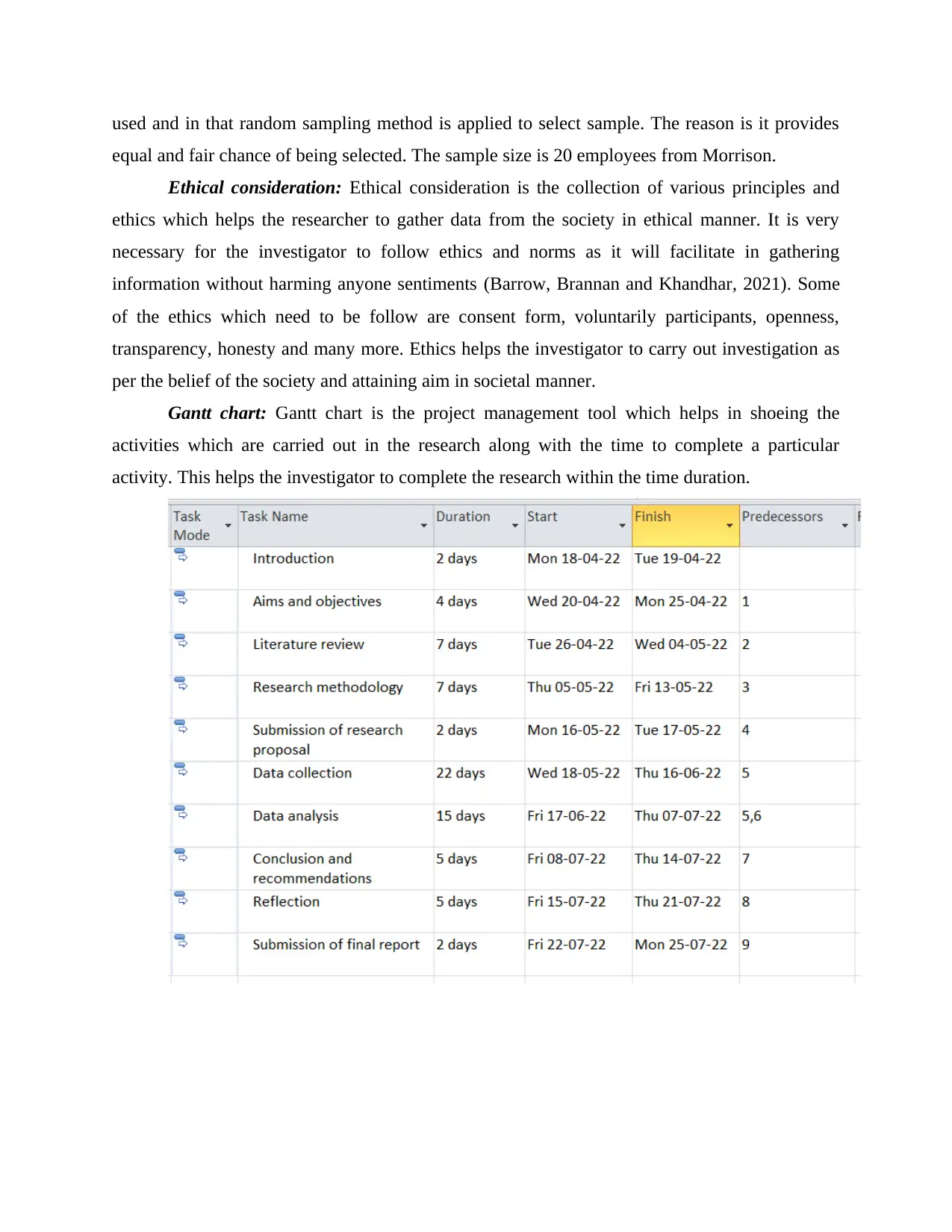
used and in that random sampling method is applied to select sample. The reason is it provides
equal and fair chance of being selected. The sample size is 20 employees from Morrison.
Ethical consideration: Ethical consideration is the collection of various principles and
ethics which helps the researcher to gather data from the society in ethical manner. It is very
necessary for the investigator to follow ethics and norms as it will facilitate in gathering
information without harming anyone sentiments (Barrow, Brannan and Khandhar, 2021). Some
of the ethics which need to be follow are consent form, voluntarily participants, openness,
transparency, honesty and many more. Ethics helps the investigator to carry out investigation as
per the belief of the society and attaining aim in societal manner.
Gantt chart: Gantt chart is the project management tool which helps in shoeing the
activities which are carried out in the research along with the time to complete a particular
activity. This helps the investigator to complete the research within the time duration.
equal and fair chance of being selected. The sample size is 20 employees from Morrison.
Ethical consideration: Ethical consideration is the collection of various principles and
ethics which helps the researcher to gather data from the society in ethical manner. It is very
necessary for the investigator to follow ethics and norms as it will facilitate in gathering
information without harming anyone sentiments (Barrow, Brannan and Khandhar, 2021). Some
of the ethics which need to be follow are consent form, voluntarily participants, openness,
transparency, honesty and many more. Ethics helps the investigator to carry out investigation as
per the belief of the society and attaining aim in societal manner.
Gantt chart: Gantt chart is the project management tool which helps in shoeing the
activities which are carried out in the research along with the time to complete a particular
activity. This helps the investigator to complete the research within the time duration.
⊘ This is a preview!⊘
Do you want full access?
Subscribe today to unlock all pages.

Trusted by 1+ million students worldwide
1 out of 31
Related Documents
Your All-in-One AI-Powered Toolkit for Academic Success.
+13062052269
info@desklib.com
Available 24*7 on WhatsApp / Email
![[object Object]](/_next/static/media/star-bottom.7253800d.svg)
Unlock your academic potential
Copyright © 2020–2025 A2Z Services. All Rights Reserved. Developed and managed by ZUCOL.





